As I have indicated here before, I revel in painting faces of our fellow human beings. I am not too sure when it first hit me that painting a face might be a good use of my ‘art’ time, but having hit upon it I find that I am enjoying myself immensely. During the process of developing the face, creating the contours and laying out all of the attendant features, I find that I manage to understand the subject better, appreciate the minute topographies that make up our faces and slowly begin to have a deeper understanding with the individual that I actually lay out on the canvas. Sometimes the face serves for storytelling – tales of deprivation, surfeit, defeat or hubris can be found. Sometimes it is the emotional expression that catches me – surprise, envy, disdain and every once in a while plain indifference. Oftentimes I also find myself reflecting on social problems that may have translated into these expressions of want, fear, hate and need etched on individuals face. Every once in a while I find myself musing on potential solutions to some of the vexing issues that these individuals might have faced in their lives. The headwater of photographs and ‘found’ images of individuals in the media serve as a source that is constantly replenished. Lately, I have been branching out a bit and photographing people myself, but that is for another post.
As far as influences go, I have a little list of artists whom I tend to idolize and wanted to share this with you…
I have great respect for Lucian Freud. His faces combine a sense of psychological tension interspersed between physical characteristics that make up his faces and seem to just simmer below the surface of the paint layer. He is famous for the usage of the hog hair brush with wide bristles dripping with thick dabs of paint help bring out the both the physical and psychological characteristics. His techniques look deceptively simple – simply load the brush with appropriate shades and dab the canvas with quick powerful strokes that blend into each other – but the overall integrity that it produces is a visual treat…
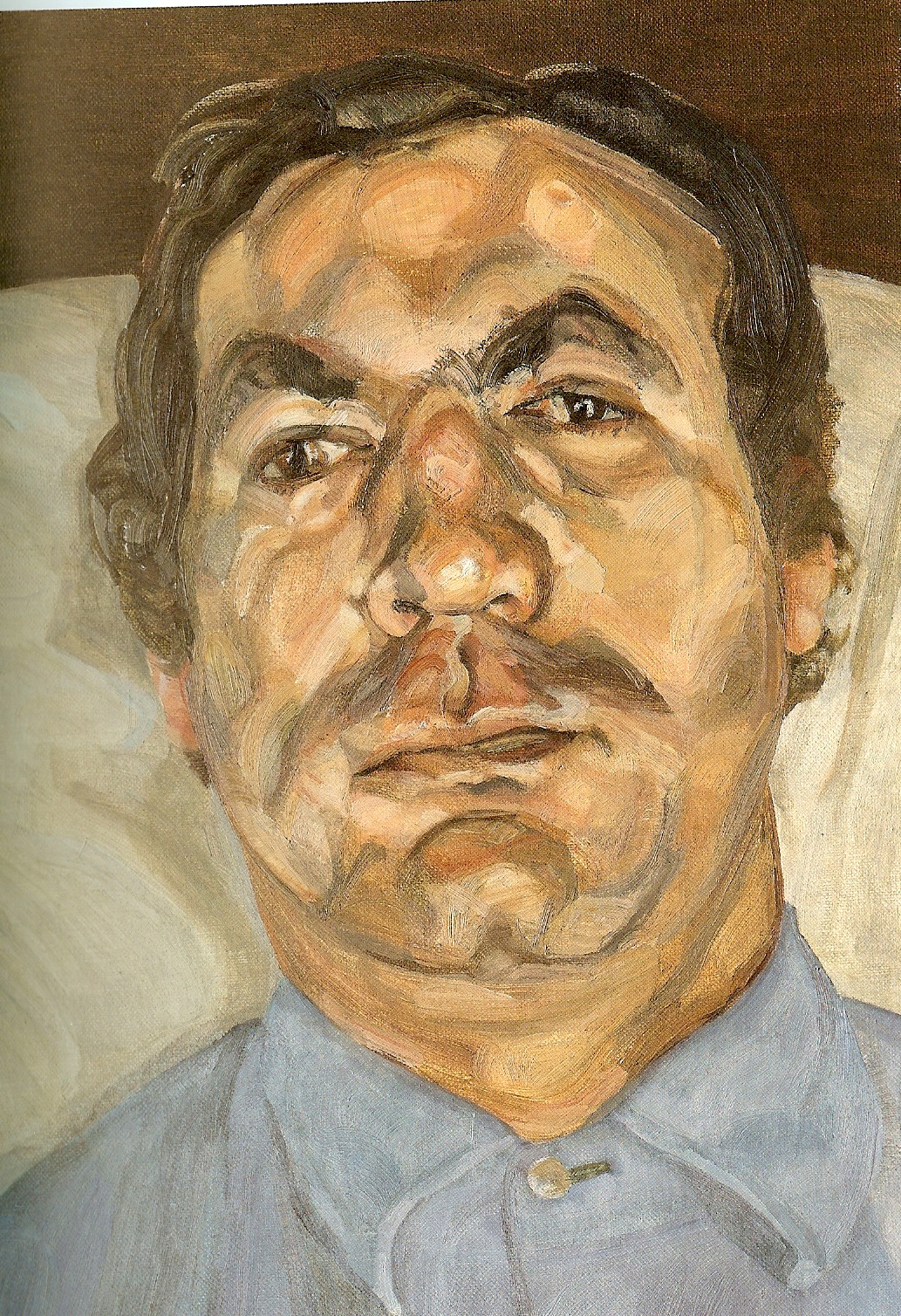
‘Head of a Man’, Oil on canvas, 1968, 13 X 10 inches, Artist: Lucian Freud
Frank Auerbach is another painter whom I admire. He has a unique style that consists of a happy marriage between simplicity and abstraction. Auerbach also tries to blend in the physical characteristics with psychological undertones resulting in a poignancy that stays with you long after you left the painting. I also know that he does not use any kind of preparatory sketches and his heavy use of impasto almost make parts of the paintings seem three dimensional. In fact there were reports that a few of his paintings were displayed flat on the ground for fear that bits of the paintings would break and fall off.
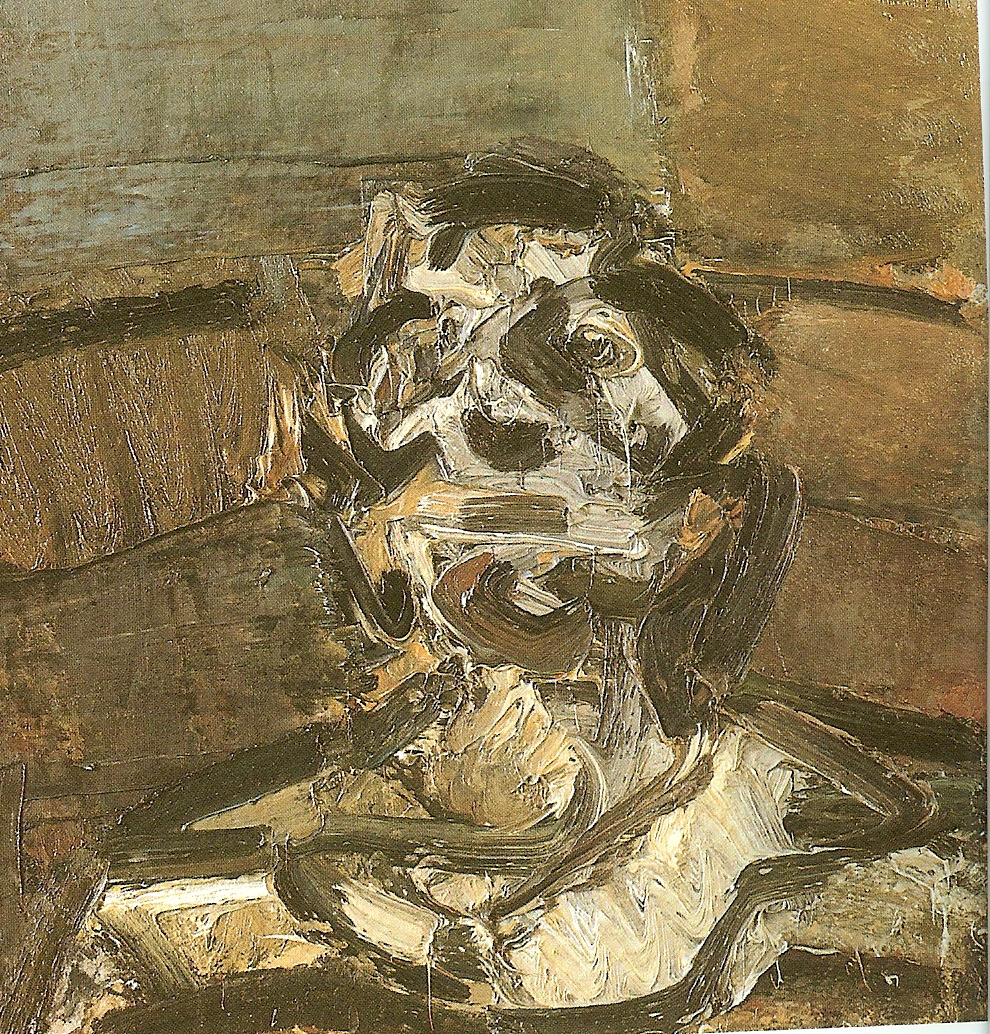
‘Head of JYM’, oil on canvas, 1982, 64 X 60 cm. Artist: Frank Auerbach
Another person whose works I study a lot from is Martin Schoeller. He is a person who in his photographs manages to inculcate the effects of truth and glamour (two normally immiscible qualities) into a generally unified portrait. He always manages to render even the greatest amongst us in all their glory juxtaposed with their attendant foibles.
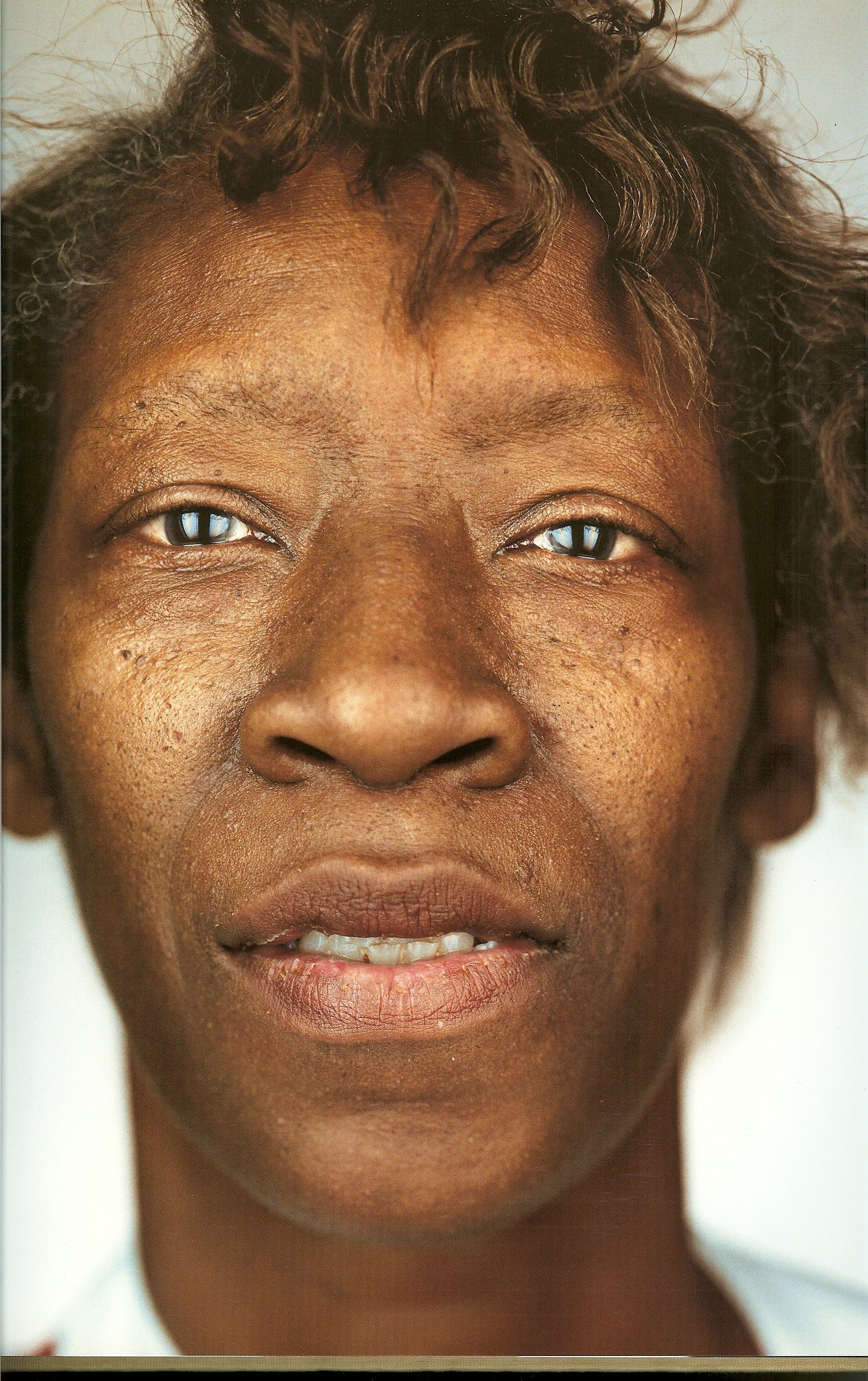
Harriet Sykes, 2004. Color print. Artist: Martin Schoeller
I also find Ron Mueck‘s sculptures to be extraordinary. Firstly in their stunning detail, secondly in their impish expressions that seem to hide deeper truths and emotions that we are not privy to… He is said to slave and labor over each of these masterpieces for months before completing one of them… He initially works on a series of small plaster maquettes that allows him to study the possibilities of positional geometry, then manages to sculpt the figure in clay, overlaying the clay with wire mesh and shellac. The ‘skin’ finally comes on as a coat of silicone or fiberglass.
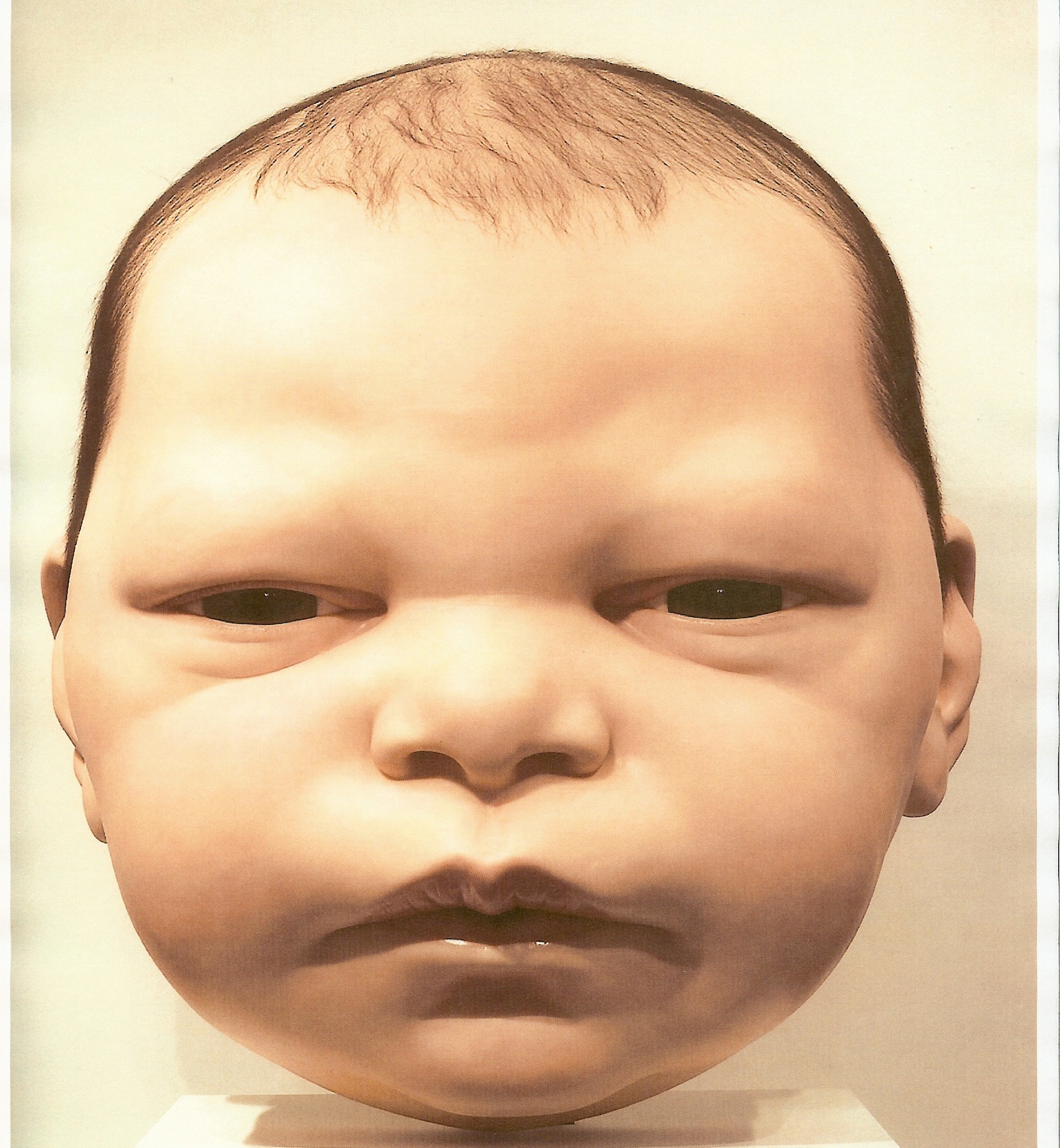
‘Head of a Baby’, 2003, 100 X 86 X 93 inches. National Gallery of Canada, Ottawa. Artist: Ron Mueck
I also find myself salivating over Albrecht Dürer‘s faces. The power in his faces come not just from the masterly composition but also derive a lot from the regal stature of the sitters that he selects for his works. The power of Dürer’s umbers, browns and flesh tones are simply stunning.
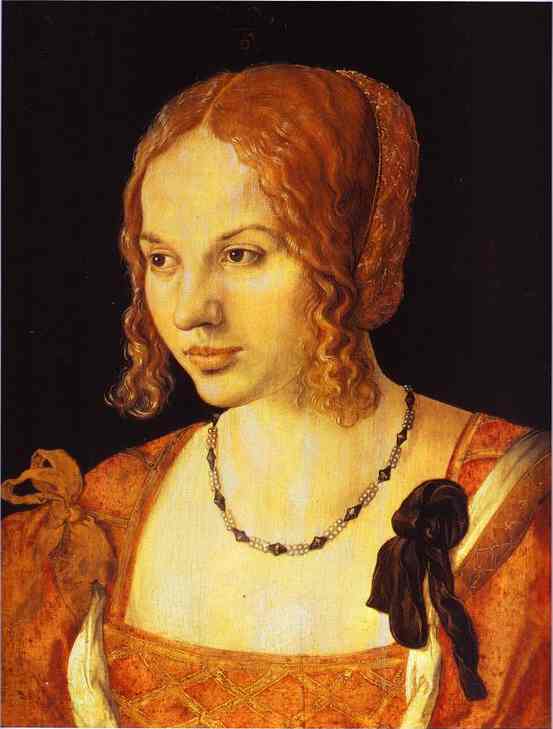
‘Portrait of a Young Venetian Woman’ 1505, Oil on panel. Kunsthistorisches Museum, Vienna, Austria. Artist: Albrecht Dürer
I did want to go on and mention Domenico Ghirlandaio and Flickr photographer Walter Callens (who happens to be one of my favorites) and so many others but I don’t want you asleep at the end of this post.
I thought I will end this post with a painting that I did a couple of months back…
‘Stomach Clock’, 2007, Oil on canvas, 36 X 48 inches. Sunil Gangadharan
What I find sad is that painting of faces is on the decline. What do you think?
Maybe it is the fact that we are so tired of each other that the only time we plan on doing a portrait of someone is when s(he) is dead or is leaving an important office/position… Maybe it was the advent of photography that heralded it – why paint a person when you can take an accurate photograph of the person and frame it? Add to all this the advent of computer based touchups of photographs and giclée printing obviates the need to paint faces anymore…
I sometimes scan listings of many auction houses (they are a good indicator on the public likes and dislikes) and also gallery offerings in New York (another good indicator of what the art market is up to nowadays) and I rarely see any form of artwork that celebrates the one thing that we never try and hide – our faces…

Impressive panel of faces.
Adults hide their faces by assuming masks. They look devout (Duerer) or stoic. The head of the baby scares me because the eyes are too adult.
I like your painting the best perhaps because the boy is open to the world. His face expresses wonder.
In terms of whole body movements, I also like those of children the best because they still express their natural grace.
Thank you, Birgit. I am glad you liked that painting.
I like the bit about masks – oftentimes I have pondered on this aspect as I develop a painting.
Sunil,
I too really enjoy your painting. He seems really alive and the color is somewhat more subtel than some of your others. THese are large heads! there is a mask like quality to a lot of your paintings, but this one feels more like the “real” face. I am intersted in seeing what you come up with by using your own photos. You capture the gesture of the head and how it attaches to the body nicley here too.
The Ron Mueck is quite creepy which i like :) Reminds me of Tony Oursler’s video projections on pillow heads. I thought you might enjoy a friend’s work, the twim series in particular – dogs with baby heads. Creepy, different kind of portraiture.
http://www.bhsu.edu/artssciences/art/website_2005/pages/Faculty/ann_porter/index.html
I am not sure that it is true that portraits are out of style. I think Freud for example is one of the most famous contemporary artists right now. And there’s Karen Kliminck, Renee Distrijke (sP? help), Collier Schor. Do you like Alice Neel or Chuck Close? Neel is a favorite of mine.
Hi Sunil, I like your painting and your post.
I’m not sure I agree with you about portraits being out of style–one example that popped into my head is Gerhard Richter.
Maybe it’s more our perspective on the art form. It’s easy to look back hundreds of years and see all these examples of portraiture and be impressed and believe it’s not the same in our times but it’s still a very active art form; we just haven’t placed the same value on it. The line of portraits of presidents here where I work may not mean too much to me today but who knows what people will think in 300 years?
Leslie, This painting was a bit different from the others. I tried to play with a little more texturing this time around and took quite some time to get it to a place where I was happy.
Yes, I like Karen Kilimnik and Alice Neel. In fact Neel is great. For some reason I do not seem to like Schorr’s work – maybe it’s because the works tends towards hyper-realism and I am not really turned on by that (of course, granted that she would be able to use an air brush when asleep is a different matter).
You know for some reason I completely forgot about Chuck Close. He is one of the finest…
The dog child sculpture of Ann Porter is a little too much for my tastes… ;-)
Tree,
You are right when you say that we have reduced the value ascribed to portraiture of late…
I always look at artwork that way – will this survive 300-500 years? How would people perceive it then? Would it then evoke similar feelings that it evokes at this point in time?
Tangentially, if you apply the 300-500 year yardstick and walk into any of the Chelsea galleries today, you would not find much of value that will stand the test of time – but then it is only by trial and error and rigorous experimentation that artworks are refined through the bench press of time to be distilled originals that will stand.
Leslie,
Since you asked: Both of the paintings hyperliked below were done after I took the pictures of the individuals myself.
http://bp0.blogger.com/_SSrRQXGMD8I/RnWEqd6oz7I/AAAAAAAAAM8/dVJ4mjC-SJ0/s400/Untitled.jpg
and
http://bp1.blogger.com/_SSrRQXGMD8I/Rhzdomd5xMI/AAAAAAAAAJU/Z2iZe3uMPVk/s400/Grandma.jpg
The current issue of Art News has an article on portraiture. The web link doesn’t show most of the pictures, but the Yang Shaobin portraits of miners’ faces reminded me a lot of yours, which I really like.
If it’s true that portraits are currently out of fashion, that’s great, they’ll probably be coming back in just as you really hit your stride. Despite my personal interest in landscape, I think that, fundamentally, people will always care most about other people.
Sunil,
Are we tlaking about the same Collier Schor? the photographer? I amnot sure what you mean about the airbrush.
http://www.pbs.org/art21/artists/schorr/index.html
THanks for showing the paintings of people you know. Grandma is very tender looking! And Ilike how her eyes go in slightly different directions. I was wondering if a different connection to the subject would come through. Or maybe you do not necessarily know them – you just took the picture? I’m not sure, but I do like that painting of her. The young boy is nice too, but his eyes are on the flat side which makes it hard to read his expression. The hard edged light shapes on his forehead and nose are also distracting – could be the photo though.
Sunil,
Certainly the Formulaic approach of most portraitists (even Freud, sometimes) feels unbearably staid. That said, I think the majority of artists being shown today are interested in people and their inter-actions. They just don’t prefer to have them be so still for so long.
I believe that the Conceptual basis for the most riveting contemporary work has finally outdated the notion of Genres and replaced it with a rangy Multimedia. It can be experienced in Chelsea (not Agora), and though it might not be your cup of tea, it can at least become an acquired taste.
Sunil,
Have you seen the You-Tube 500 Years of Female Portraits in Western Art?
http://www.youtube.com/watch?v=nUDIoN-_Hxs
These are fades or morphs between famous portraits that we are all familiar with, but what is most fascinating is to watch the eyes and mouth as the video moves from one to the next.
By the way, Mueck’s baby strikes me as the most amazing creature — definitely not a blank page.
D. Ragged Cloth right now has a post on Diego Rivera’s mural — they are a throwback to the big old history paintings, but perhaps because it isn’t European history ( or at least it’s a view from a different angle) I’m finding them fascinating. The multiplicity of figures and the interactions between them (“interaction” in your post is what set me off) is wonderful. I wish there were a way to do a You-Tube video, like the Female Portraits, using Rivera’s faces.
June,
Maybe my favorite art experience happened about twenty-five years ago in the National Galley in DC.
I stopped to view a painting of Napolean by David. Napolean was, as expected, calm, arrogant and… surprisingly dumpy. I was amused and looked at him for awhile, long enough to follow his gaze. I turned around. There was Ingres’ remarkable “Madame Moitessier”. She did not look pleased.
(And: did you notice the dimensions of the Mueck. And he only thrills at close examination.)
D.
Indeed I did note the dimensions of the Mueck baby — definitely my preferred size of progeny (art progeny, that is).
In our family we have a (sly) way of admiring drooling babies held up to our perhaps too-jaded eyes; “My, that _is_ a baby.”
Sunil,
You are good at painting eyes. I still remember the look on Evening Melody’s face.
I just wanted to find some images by Auerbach, because an artist friend recommended him. What a great article you have written on your own inspirations ! I have learnt so much for my life drawing class efforts and you have inspired me to find out and discover more modern artists. Great stuff and many thanks.